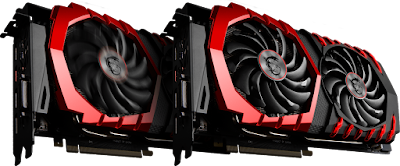GTX1070 MSI vs Super Jetstream 1070 Palit
Why Buy a Graphics Card?
Whether you're a gamer, a video editor or a graphic designer, you need a computer with powerful graphics capabilities. Unless you upgraded when you bought your computer, its graphics chipset is likely integrated with the CPU or even motherboard. Often called onboard video, such a solution shares system memory and processing power with your computer, which can make graphics-intensive applications work painfully slowly. What you need is a discrete graphics card with ample processing power and video memory. Such cards fit into a slot on your motherboard and connect directly to your monitor.
GTX1070 MSI
Red Dragon
The GTX1070 is fast becoming the most embraced card of the Nvidia’s 10 series (Pascal) line. While it might not be as powerful as the top of the line GTX 1080, the lower price and high performance means that it makes a good replacement to the popular GTX 970. With a little tweak in terms of performance and design, MSI has released their own version of this card, the MSI GTX 1070 Gaming X 8GB.
Slim Shady
While the card is quite large when viewed directly from the top, it sports slim profile. Thanks to the large fans, it’s exactly two slots high, meaning that you can use the third PCI slot directly beneath it. A large black aluminum bracket at the rear keeps the card from sagging under its own weight. The backplate has various holes to help with cooling, as well as an MSI dragon logo etched on for that extra coolness.
SUPER JETSREAM 1070 PALIT
Overclocking Goodness
The card is super overclocked. At 1633 Mhz base and 1835 Mhz boosted, this is one of the fastest GTX 1070 that can be found on the market. Amazingly, the card only need one (1!) 8 pin GPU power connector to work, and uses only 225W. You cn also overclock the card using Palit’s own overclocking software.
Quite Baby
The large cooling helps the card to be quite when not under load. The fans would only start spinning up when the temperature hits 55 degrees celcius. But all of this makes card heavy. Really heavy. To help with the weight, a large slab aluminum backplate is installed to make sure that the card does not bend under its own weight.
TopTenReviews have posted comparison, reviews & prices for these top rated Video Cards,
Graphics Cards: What to Look For
Graphics cards continue to get faster and more powerful, and the options can seem overwhelming. To find the right one, first consider how you'll use it. If you want to play the latest games at ultra-high settings and resolutions higher than 1080p, you'll be happiest with a high-end card. If you just want to edit videos, a midrange card still provides a vast improvement over integrated graphics. This guide will help you choose the right graphics card for your needs.
Noise and Power
Generally, the more work your graphics card needs to do, the more electricity it consumes and the hotter it runs. Thus, high-end cards usually use more electricity and run hotter, but they provide you with significantly more rendering power. What you want is a balance. Nvidia does a particularly good job of keeping its cards relatively quiet and powerful. AMD graphics cards are notorious for their fans being quite loud.
Rendering Technologies
The two major players in the graphics card world are AMD and Nvidia. Each has developed its own rendering technology for processing graphical data. Nvidia graphics cards use CUDA cores, and AMD uses stream processors. While these technologies are measured differently, their purpose is to accelerate the communication rate between the graphics card's GPU and your computer's CPU. The more CUDA cores or stream processors a card has, the faster it is, and this makes your program or game run smoother and faster. AMD and Nvidia have also made great strides in offering 3D capabilities.
Supported API
The application programming interface (API) – DirectX, Mantle, OpenGL or OpenCL – enables the card to interact with your software. Choose a card that's compatible with the API of the programs you wish to run. For example, if your card supports only DirectX 9 and you buy a game or application that requires DirectX 11, you have to upgrade your card in order to play it.
Source: TopTenReviews
Whether you're a gamer, a video editor or a graphic designer, you need a computer with powerful graphics capabilities. Unless you upgraded when you bought your computer, its graphics chipset is likely integrated with the CPU or even motherboard. Often called onboard video, such a solution shares system memory and processing power with your computer, which can make graphics-intensive applications work painfully slowly. What you need is a discrete graphics card with ample processing power and video memory. Such cards fit into a slot on your motherboard and connect directly to your monitor.
GTX1070 MSI
Red Dragon
The GTX1070 is fast becoming the most embraced card of the Nvidia’s 10 series (Pascal) line. While it might not be as powerful as the top of the line GTX 1080, the lower price and high performance means that it makes a good replacement to the popular GTX 970. With a little tweak in terms of performance and design, MSI has released their own version of this card, the MSI GTX 1070 Gaming X 8GB.
Slim Shady
While the card is quite large when viewed directly from the top, it sports slim profile. Thanks to the large fans, it’s exactly two slots high, meaning that you can use the third PCI slot directly beneath it. A large black aluminum bracket at the rear keeps the card from sagging under its own weight. The backplate has various holes to help with cooling, as well as an MSI dragon logo etched on for that extra coolness.
SUPER JETSREAM 1070 PALIT
Overclocking Goodness
The card is super overclocked. At 1633 Mhz base and 1835 Mhz boosted, this is one of the fastest GTX 1070 that can be found on the market. Amazingly, the card only need one (1!) 8 pin GPU power connector to work, and uses only 225W. You cn also overclock the card using Palit’s own overclocking software.
Quite Baby
The large cooling helps the card to be quite when not under load. The fans would only start spinning up when the temperature hits 55 degrees celcius. But all of this makes card heavy. Really heavy. To help with the weight, a large slab aluminum backplate is installed to make sure that the card does not bend under its own weight.
TopTenReviews have posted comparison, reviews & prices for these top rated Video Cards,
Graphics Cards: What to Look For
Graphics cards continue to get faster and more powerful, and the options can seem overwhelming. To find the right one, first consider how you'll use it. If you want to play the latest games at ultra-high settings and resolutions higher than 1080p, you'll be happiest with a high-end card. If you just want to edit videos, a midrange card still provides a vast improvement over integrated graphics. This guide will help you choose the right graphics card for your needs.
Performance
Whatever a graphics card looks like or its specifications are, all you really need to know is how it performs. Can it handle your favorite games at the highest settings, and at what resolutions? We created our graphics card comparison by compiling test data across a slew of modern games. We tested all of the games at 1080p with the highest settings and recorded their average frame rates. We also looked at 4K performance. Higher frame rates are better, as they provide a smoother rendering experience and are a good indication of more power.
GPU
The most important aspect of a graphics card is its graphics processing unit, or GPU. By processing graphics separately, the GPU lightens the load of your computer's CPU, allowing it to function faster. Look for a card with a high core clock speed and memory clock speed. These two factors help determine a card's memory bandwidth, which in turn affects frame rate. Faster frame rates result in smoother scrolling and animation. Pixel and texture fillrates are also important to consider.
Noise and Power
Generally, the more work your graphics card needs to do, the more electricity it consumes and the hotter it runs. Thus, high-end cards usually use more electricity and run hotter, but they provide you with significantly more rendering power. What you want is a balance. Nvidia does a particularly good job of keeping its cards relatively quiet and powerful. AMD graphics cards are notorious for their fans being quite loud.
Rendering Technologies
The two major players in the graphics card world are AMD and Nvidia. Each has developed its own rendering technology for processing graphical data. Nvidia graphics cards use CUDA cores, and AMD uses stream processors. While these technologies are measured differently, their purpose is to accelerate the communication rate between the graphics card's GPU and your computer's CPU. The more CUDA cores or stream processors a card has, the faster it is, and this makes your program or game run smoother and faster. AMD and Nvidia have also made great strides in offering 3D capabilities.
The application programming interface (API) – DirectX, Mantle, OpenGL or OpenCL – enables the card to interact with your software. Choose a card that's compatible with the API of the programs you wish to run. For example, if your card supports only DirectX 9 and you buy a game or application that requires DirectX 11, you have to upgrade your card in order to play it.
Source: TopTenReviews














No comments: